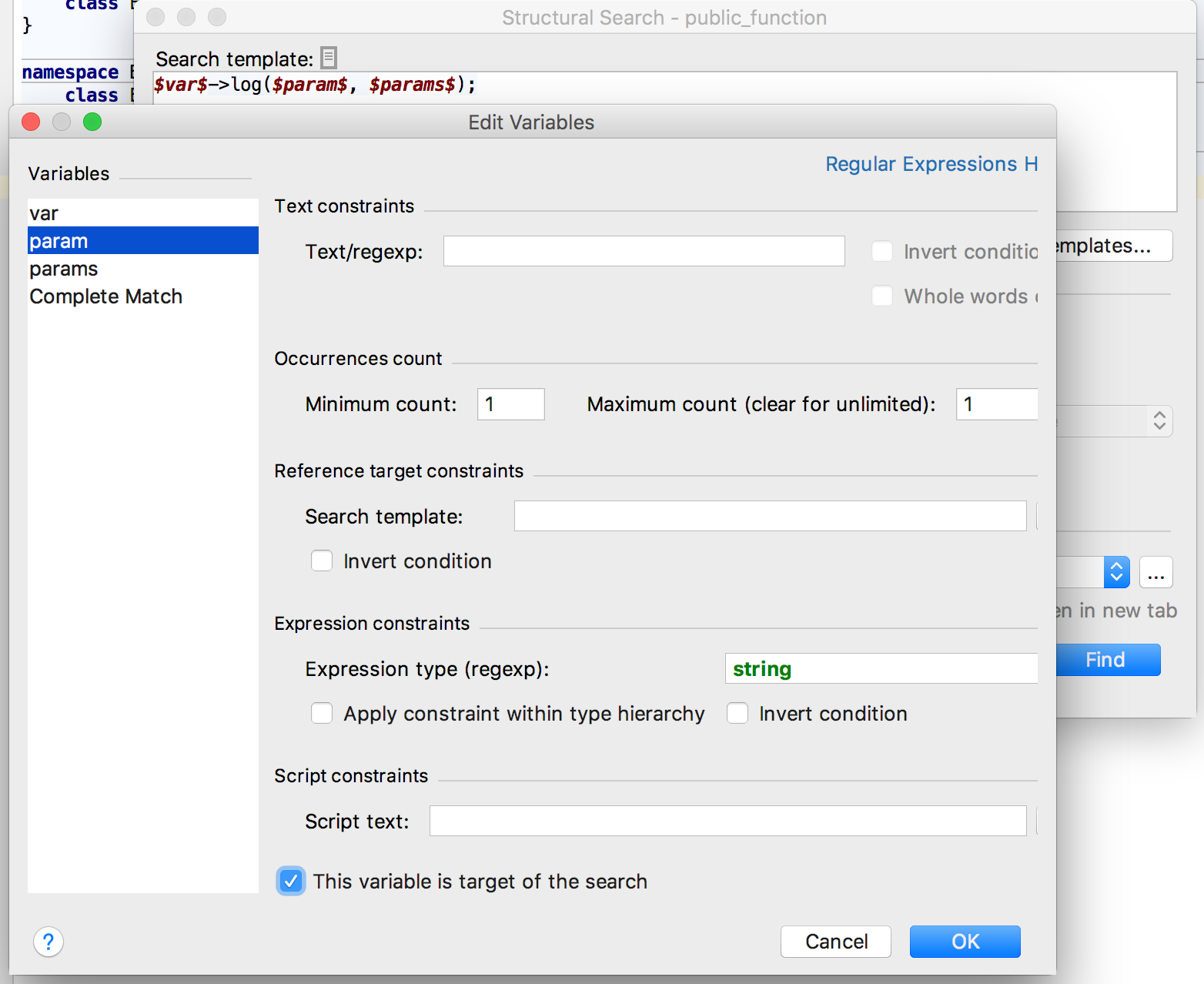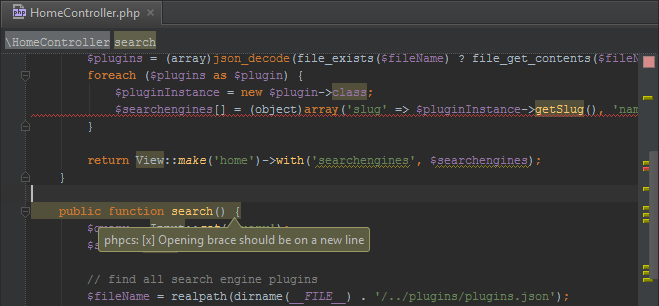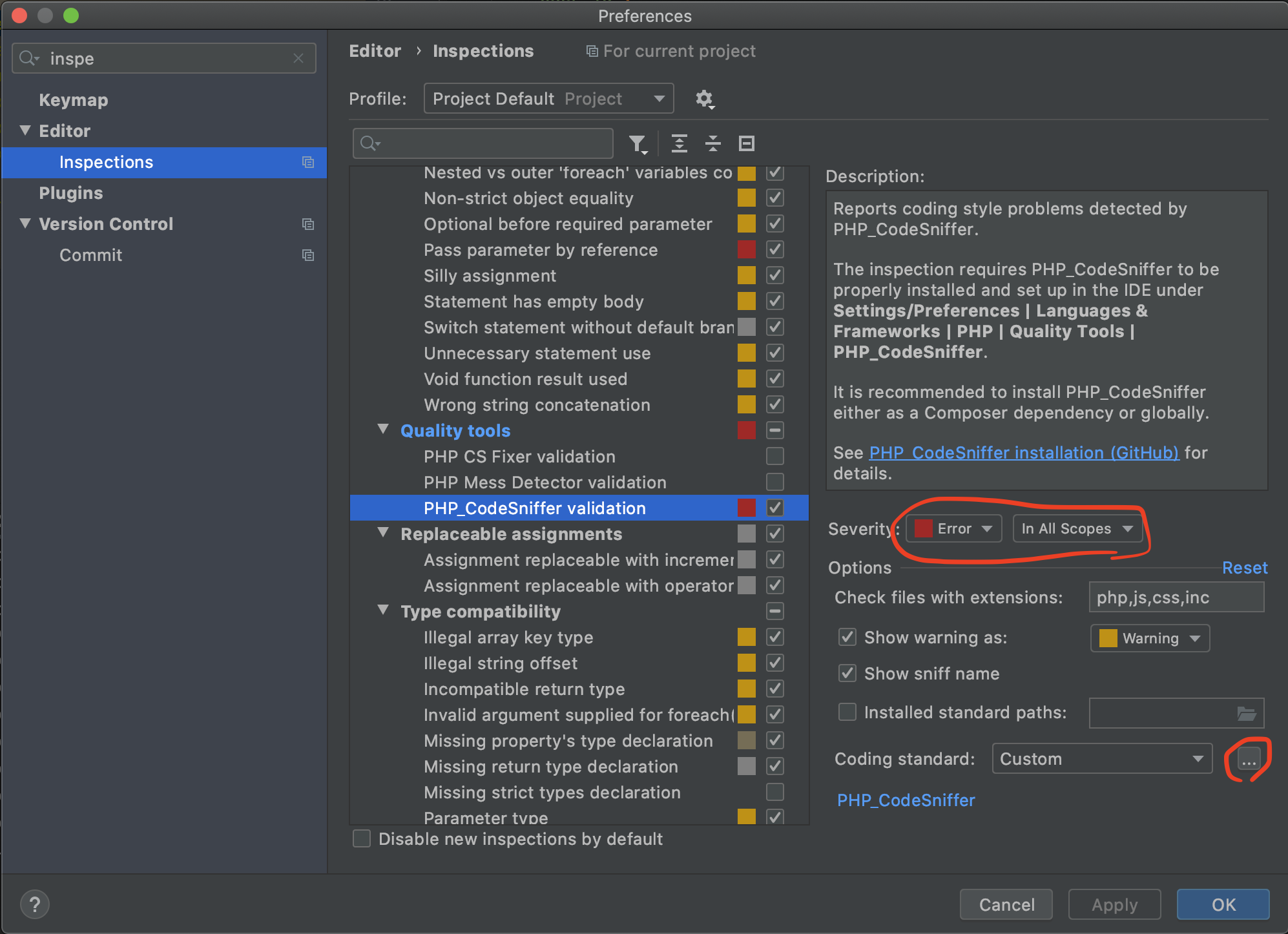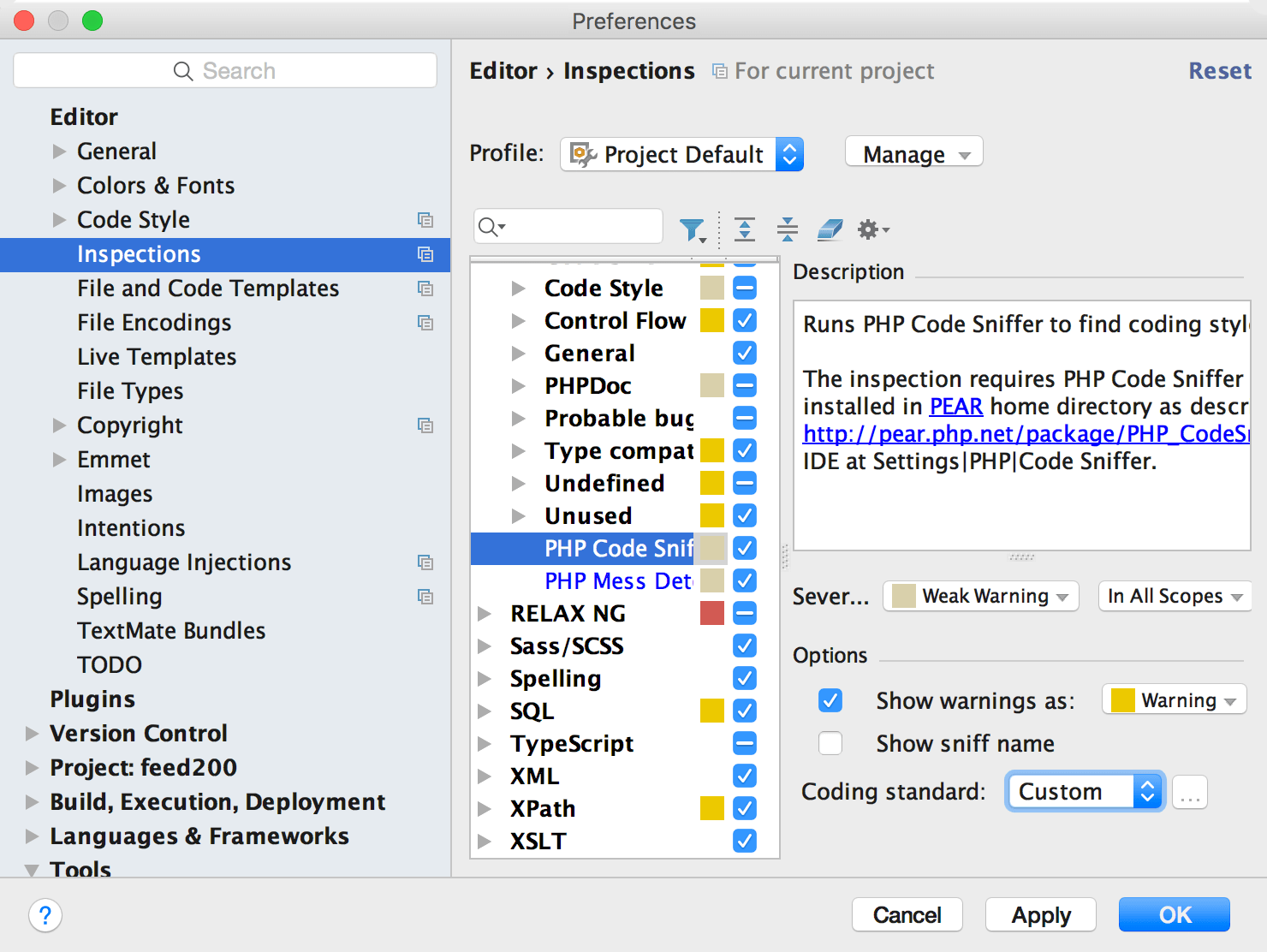PhpStorm provides code style check through integration with the PHP_CodeSniffer tool, which validates your code for consistency with a coding standard of your choice. You can appoint one of the predefined coding standards or use your own previously defined coding standard with the root directory outside the default PHP_CodeSniffer’s Standards directory. Moreover, you can share your custom coding style with your team.
To use PHP_CodeSniffer from PhpStorm instead of command line, you need to register it in PhpStorm and configure it as a PhpStorm code inspection. Once installed and enabled in PhpStorm, the tool is available in any opened PHP file, and no additional steps are required to launch it. The on-the-fly code check is activated upon every update in the file thus making it easy to get rid of discovered problems.
Errors and warnings reported by PHP_CodeSniffer on-the-fly are displayed as popup messages. When the tool is run in the batch mode, the errors and warnings are displayed in the Inspection Results tool window. Each message has the phpcs prefix to distinguish it from PhpStorm internal inspections. PhpStorm also integrates with the PHP Code Beautifier and Fixer tool, which lets you fix many of the detected issues.


- The CodeSniffer itself should reside in d:programphpPEARPHPCodeSniffer - there will be a script autoload.php and a subfolder src. Then in Settings - Languages & Frameworks - PHP - Code Sniffer you specify the path to phpcs.bat and Validate it.
- PHP Code Sniffer is a PHP5 script that tokenises PHP, JavaScript and CSS files to detect violations of a defined coding standard. It is an essential development tool that ensures your code remains clean and consistent. It can also help prevent some common semantic errors made by developers.
- In a previous post, we learned how to use the tool PHPCodeSniffer to accomplish with the WordPress and WooCommerce standards and make our code more readable, robust, and secure. But executing a command in our terminal every time we want to check if the code we.
Use php CodeSniffer commands, pointed towards your xml file, to sniff the code using the new ruleset.
Prerequisites
Prior to integrating PHP_CodeSniffer in PhpStorm, make sure the following prerequisites are met:
You are working with PHP_CodeSniffer version 1.5.0 and later.
The directory containing the PHP engine executable must be added to the system
path. This allows code quality tool scripts execute calls to the system-wide PHP engine.For Docker Compose-based remote interpreters, make sure to use
execComputer memory cleaner. mode to avoid spawning additional containers.In the Settings/Preferences dialog Ctrl+Alt+S, go to PHP.
On the PHP page that opens, click next to the CLI Interpreter list.
In the CLI Interpreters dialog that opens, set the Lifecycle mode for the selected interpreter to Connect to existing container ('docker-compose exec').
Install and configure PHP_CodeSniffer
PHP_CodeSniffer scripts can be used as local scripts, the scripts associated with PHP interpreters, or scripts declared as project dependencies and installed via Composer, which is the preferable and recommended way.
Install PHP_CodeSniffer with Composer
Before you start, make sure Composer is installed on your machine and initialized in the current project as described in Composer dependency manager.
When you install PHP_CodeSniffer with Composer, PhpStorm automatically downloads the necessary scripts, registers them in the IDE, and, optionally, enables and configures the corresponding code inspection.
Inside composer.json, add the squizlabs/php_codesniffer dependency record to the
requireorrequire-devsection. Press Ctrl+Space to get code completion for the package name and version.Do one of the following:
Click the Install shortcut link on top of the editor panel.
If the Non-installed Composer packages inspection is enabled, PhpStorm will highlight the declared dependencies that are not currently installed. Press Alt+Enter and select whether you want to install a specific dependency or all dependencies at once.
Click next to the package record in the composer.json editor gutter to jump to the corresponding Settings/Preferences page and configure PHP_CodeSniffer manually.
Reset PHP_CodeSniffer configuration
After PHP_CodeSniffer is initially configured, further modifications in composer.json will not affect the inspection configuration. To apply newer changes, reset the PHP_CodeSniffer configuration.
In the Settings/Preferences dialog Ctrl+Alt+S, navigate to PHP | Quality Tools.
On the Quality Tools page that opens, expand the PHP_CodeSniffer area and click next to the Configuration list.
In the PHP_CodeSniffer dialog that opens, empty the PHP_CodeSniffer path field.
Update the project Composer dependencies by clicking Update on top of the composer.json editor panel. See Update dependencies for details.
PhpStorm will perform the PHP_CodeSniffer configuration anew and thus apply the changes in composer.json.
Configure PHP_CodeSniffer manually
You can use the manually downloaded local PHP code quality tool scripts or scripts associated with PHP interpreters. There can be a number of local and remote PHP interpreters, the one specified on the PHP page of the Settings/Preferences dialog is considered Project Default. Learn more about configuring PHP interpreters in Configure remote PHP interpreters or in Configure local PHP interpreters.
Choose a PHP_CodeSniffer script to use
In the Settings/Preferences dialog Ctrl+Alt+S, navigate to PHP | Quality Tools.
On the Quality Tools page that opens, expand the PHP_CodeSniffer area. From the Configuration list, choose the PHP_CodeSniffer script:
To use the script associated with a specific remote PHP interpreter, choose the name of this interpreter.
To use a local script, choose Local. In this case the local PHP_CodeSniffer will be executed no matter which PHP interpreter - local or remote - is used in the project. Note that there can be only one Local configuration for PHP_CodeSniffer because PhpStorm runs a script (phpcs.bat for Windows or phpcs for Linux and macOS) that contains a path to a PHP engine.
To use the script associated with the default project interpreter, that is, the one chosen on the PHP page of the Settings/Preferences dialog, choose By default project interpreter.
Configure a local PHP_CodeSniffer script
Download and install the PHP_CodeSniffer scripts.
To check the PHP_CodeSniffer installation, switch to the installation directory and run the following command:
If the tool is available, you will get a message in the following format:
PHP_CodeSniffer version <version> (stable) by Squiz. (http://www.squiz.net)To have code checked against your own custom coding standard, create it. Store the rules and the ruleset.xml file that points to them in the coding standard root directory.
Register the local PHP_CodeSniffer script in PhpStorm:
Audacity get into pc. Audacity is a free multi-track audio editor and recorder. The freeware enables people to go beyond the basics of sound editing by offering high-quality audio, plug-ins, etc. Developed by volunteers, the audio file tool was released in 2000 and continues to receive consistent updates. Audacity is compatible with Apple Mac, Linux, and Windows Microsoft operating systems. Free, open source, cross-platform audio software. Audacity is an easy-to-use, multi-track audio editor and recorder for Windows, Mac OS X, GNU/Linux and other operating systems. Developed by a group of volunteers as open source and offered free of charge. Amazing support community. Download Audacity for Windows, Mac or Linux; Audacity is free of charge. No registration or hardware purchase required. Audacity on Windows is only available as a 32-bit application that may be used on 32-bit or 64-bit systems. For macOS Audacity 3.x is 64-bit. Legacy Downloads.
In the Settings/Preferences dialog Ctrl+Alt+S, navigate to PHP | Quality Tools.
On the Quality Tools page that opens, expand the PHP_CodeSniffer area and click next to the Configuration list.
In the PHP_CodeSniffer dialog that opens, specify the location of the phpcs.bat or phpcs PHP_CodeSniffer executable in the PHP_CodeSniffer path field. Type the path manually or click and select the relevant folder in the dialog that opens.
To check that the specified path to phpcs.bat or phpcs ensures interaction between PhpStorm and PHP_CodeSniffer, that is, the tool can be launched from PhpStorm and PhpStorm will receive problem reports from it, click the Validate button. This validation is equal to running the
phpcs --versioncommand. If validation passes successfully, PhpStorm displays the information on the detected PHP_CodeSniffer version.
If necessary, in the Tool process timeout field, specify how long you want PhpStorm to wait for a result from PHP_CodeSniffer, whereupon the process is terminated to prevent excessive CPU and memory usage.
If necessary, in the PHP Code Beautifier and Fixer Settings area provide the path to the PHP Code Beautifier and Fixer tool in the Path to phpcbf field. This will let you automatically fix many of the errors detected by PHP_CodeSniffer. If you install PHP_CodeSniffer with Composer, PHP Code Beautifier and Fixer is detected and set up automatically.
Configure a PHP_CodeSniffer script associated with a PHP interpreter
In the Settings/Preferences dialog Ctrl+Alt+S, go to PHP | Quality Tools.
On the Quality Tools page that opens, expand the PHP_CodeSniffer area and click next to the Configuration list. The PHP_CodeSniffer dialog opens showing the list of all the configured PHP_CodeSniffer scripts in the left-hand pane, one of them is of the type Local and others are named after the PHP interpreters with which the scripts are associated.
Click on the toolbar. In the PHP_CodeSniffer by Remote Interpreter dialog that opens, choose the remote PHP interpreter to use the associated script from. If the list does not contain a relevant interpreter, click and configure a remote interpreter in the CLI Interpreters dialog as described in Configure remote PHP interpreters.
When you click OK, PhpStorm brings you back to the PHP_CodeSniffer dialog where the new PHP_CodeSniffer Drivers realtek usb devices. configuration is added to the list and the right-hand pane shows the chosen remote PHP interpreter, the path to the PHP_CodeSniffer associated with it, and the advanced PHP_CodeSniffer options.
If necessary, in the Tool process timeout field, specify how long you want PhpStorm to wait for a result from PHP_CodeSniffer, whereupon the process is terminated to prevent excessive CPU and memory usage.
If necessary, in the PHP Code Beautifier and Fixer Settings area provide the path to the PHP Code Beautifier and Fixer tool in the Path to phpcbf field. This will let you automatically fix many of the errors detected by PHP_CodeSniffer. If you install PHP_CodeSniffer with Composer, PHP Code Beautifier and Fixer is detected and set up automatically.
Configure PHP_CodeSniffer as a PhpStorm inspection
Configure the PHP_CodeSniffer inspection with Composer
You can include the information on the default and custom PHP_CodeSniffer rulesets inside the scripts section of composer.json. When you install or update project dependencies, the specified rulesets will be detected and the PHP_CodeSniffer validation inspection will be enabled automatically.
If no ruleset is specified in the scripts section of composer.json, PhpStorm will additionally check the project root to locate the ruleset with the phpcs.xml default name. If the file is present, it will be automatically selected as the inspection's Custom ruleset.
In the
scriptssection of composer.json, add thephpcsPHP_CodeSniffer launch command into one of the leaf elements.Provide the
--standardargument to denote the coding standard used. For example, adding the following record will set the coding standard to PSR2:Adding the following record will set the coding standard to Custom and the path to the ruleset to <project root>/phpcs.xml:
'scripts': { 'phpcs': 'phpcs --standard=phpcs.xml' }
Additionally, you can provide a custom non-PSR standard dependency inside the require-dev section of composer.json to have it detected automatically. Currently, the following standards are supported:
After PHP_CodeSniffer is initially configured, further modifications in composer.json will not affect the inspection configuration. To apply newer changes, reset the PHP_CodeSniffer configuration on the PHP | Quality Tools page of the Settings/Preferences dialog Ctrl+Alt+S and update project dependencies.
Configure the PHP_CodeSniffer inspection manually
In the Settings/Preferences dialog Ctrl+Alt+S, click Inspections under Editor.
On the Inspections page that opens, expand the PHP | Quality Tools node and select the checkbox next to PHP_CodeSniffer validation.
If you have installed PHP_CodeSniffer with Composer but the corresponding inspection is currently disabled, PhpStorm highlights its record in composer.json. Press Alt+Enter and use the provided Enable inspection quick-fix to enable the inspection and open the Inspections page.
On the right-hand pane of the page, configure the PHP_CodeSniffer tool using the controls in the Options area:
From the Severity list, choose the severity degree for the PHP_CodeSniffer inspection. The selected value determines how serious the detected discrepancies will be treated by PhpStorm and presented in the inspection results.
From the Scope list, choose the scope to limit the inspection application to.
In the Check files with extensions field, provide the comma-separated list of file extensions that should be checked by PHP_CodeSniffer.
To have PHP_CodeSniffer report warnings in addition to errors, select the Show warnings as.. checkbox and choose the severity degree from the list. To have only errors reported and suppress reporting warnings, clear Show warnings as.. checkbox.
If you are relying on a custom third-party coding standard (for example, Coder or Joomla Coding Standards ), you need to integrate it with PHP_CodeSniffer prior to using it. To do this, select the Installed standard paths checkbox, click and select the custom standard installation directory in the dialog that opens.
Select the Show sniff name checkbox to have the corresponding sniff's name displayed in the editor or the inspection results in addition to the inspection summary.
Appoint the coding standard to apply.
To use one of the predefined coding standards, select it the Coding standard list, appoint the coding style to check your code against. The list contains all the coding standards installed inside the main php_codesniffer directory structure.
To have your code checked against your own previously defined coding standard, choose Custom. Click and in the Custom Coding Standard dialog that opens, specify the path to the ruleset.xml file for your own coding standard in the Path to ruleset field. Type the path manually or click and choose the relevant folder in the dialog that opens.
Fix issues detected by PHP_CodeSniffer
PhpStorm integrates with the PHP Code Beautifier and Fixer tool, which lets you fix many of the detected issues. If you install PHP_CodeSniffer with Composer, PHP Code Beautifier and Fixer will be detected and set up automatically. Otherwise, you need to set it up manually.
Fix issues by using a quick-fix
Upon detecting an issue, PhpStorm highlights it in accordance with the PHP_CodeSniffer inspection settings.
Place the caret at the detected issue and click , or press Alt+Enter.
Select PHP Code Beautifier and Fixer: fix the whole file from the popup menu. Note that this will fix all issues detected in the current file.
You can also detect issues in the batch mode, or fix them automatically with code cleanup.
Fix issues automatically with Code Cleanup
From the main menu, select Code | Code Cleanup.
In the Specify Code Cleanup Scope dialog that opens, select ths scope to which you want the inspection profile to be applied.
Select the inspection profile from the list, or click to configure a new profile in the Code Cleanup Inspections dialog that opens. You can also click to check, which fixes will be applied and make sure that the PHP_CodeSniffer validation inspection is enabled.
Click OK to launch code cleanup.
Run PHP_CodeSniffer in the batch mode
From the main menu, select Code | Inspect code.
Select the inspection profile from the list, or click to configure a new profile in the Inspections dialog that opens. You can also click to check, which fixes will be applied and make sure that the PHP_CodeSniffer validation inspection is enabled.
View the inspection results in the Inspection results tool window. Errors and warnings reported by PHP_CodeSniffer are prefixed with
phpcsto distinguish them from PhpStorm internal inspections.
Exclude files from PHP_CodeSniffer Validation inspection
When waiting for PHP_CodeSniffer response exceeds the limit specified in the Tool process timeout field in the PHP_CodeSniffer dialog, PhpStorm suggests adding the file to the ignore list.

In the Settings/Preferences dialog Ctrl+Alt+S, navigate to PHP | Quality Tools.
On the Quality Tools page that opens, expand the PHP_CodeSniffer area and click the Show ignored files link.
To add a file, click and locate the desired file in the dialog that opens.
To delete a file from the list and have PHP_CodeSniffer process it again, select the file and click .
To remove all the files from the list, click .
CodeSniffer is a tool to detect coding standard violation for PHP, CSS and Javascript. It is really useful to check if the codes you made violate the coding standard you defined. When you work in a team, this tool can help a lot. Today, I'm going to show how to setup CodeSniffer on PHPStorm.
Installation
There are two ways to install CodeSniffer, using PEAR or using Composer. I prefer use Composer for this one. You need to execute command below to install CodeSniffer
[php] composer global require 'squizlabs/php_codesniffer=*' [/php]

We install CodeSniffer as global command so PHPStorm can always make reference to it. This command will install CodeSniffer in this path /Users/masbugan/.composer/vendor/bin/phpcs
Setup on PHPStorm
Here is how to insert reference for CodeSniffer
- Go to menu Preferences
- Choose PHP -> Code Sniffer
- Insert the CodeSniffer path to the input text and click Validate
- Click Apply and you are done
Phpstorm Codesniffer Ruleset
Change CodeSniffer Setting
To make CodeSniffer run, you need to set PHPStorm to use it when inspect codes. Here is the step
- Go to Preferences
- Go to Inspections -> PHP
- Check the PHP Code Sniffer Validation
- You can also define coding standard you want there.
Code Sniffer Phpstorm Windows
Test CodeSniffer
CodeSniffer can be executed via menu Code -> Inspect Code. You can choose to inspect whole project or just current file. Then PHPStorm will list the inspection result.
Phpstorm Codesniffer Xml
Summary
Squizlabs/php_codesniffer Phpstorm
That is it how to setup CodeSniffer on PHPStorm. You will be really helped with this tool to make your codes always match with defined coding standard.
